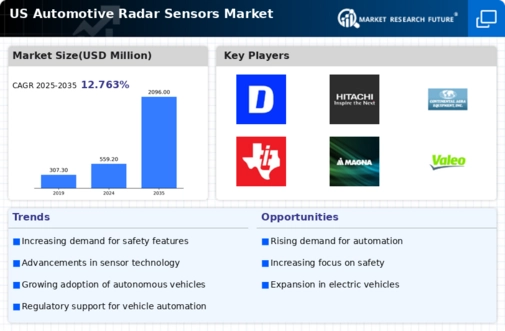Rising Demand for Enhanced Safety Features
The automotive radar-sensors market is experiencing a notable surge in demand for enhanced safety features in vehicles. As consumers increasingly prioritize safety, manufacturers are integrating advanced radar-sensor technologies to support features such as collision avoidance and adaptive cruise control. According to recent data, the market for automotive safety systems is projected to grow at a CAGR of approximately 10% through 2027. This growth is driven by regulatory pressures and consumer expectations for higher safety standards, compelling automakers to invest in radar-sensor technologies. Consequently, the automotive radar-sensors market is positioned to benefit significantly from this trend, as it aligns with the broader industry shift towards safer driving experiences.
Government Regulations and Safety Standards
Government regulations and safety standards play a crucial role in shaping the automotive radar-sensors market. In the US, regulatory bodies are increasingly mandating the inclusion of advanced safety features in new vehicles, which often rely on radar-sensor technologies. For instance, the National Highway Traffic Safety Administration (NHTSA) has proposed regulations that encourage the adoption of systems designed to prevent accidents. This regulatory environment is expected to drive the automotive radar-sensors market, as manufacturers seek to comply with these standards and enhance vehicle safety. The market is likely to see a compound annual growth rate (CAGR) of around 8% as a result of these regulatory pressures.
Technological Advancements in Radar Technology
Technological advancements in radar technology are propelling the automotive radar-sensors market forward. Innovations such as higher frequency bands and improved signal processing capabilities enhance the accuracy and reliability of radar systems. These advancements enable vehicles to detect obstacles and other vehicles more effectively, thereby improving overall safety. The automotive radar-sensors market is projected to reach a valuation of $5 billion by 2026, reflecting a growing recognition of the importance of these technologies. As manufacturers continue to innovate, the integration of sophisticated radar systems into vehicles is likely to become more prevalent, further driving market growth.
Increased Investment in Research and Development
Increased investment in research and development (R&D) is a key driver of the automotive radar-sensors market. As competition intensifies, manufacturers are allocating more resources to innovate and improve radar technologies. This focus on R&D is likely to lead to the development of more sophisticated radar systems that offer enhanced performance and reliability. Industry reports indicate that R&D spending in the automotive sector is expected to rise by 15% annually, reflecting the industry's commitment to advancing radar-sensor technologies. This investment is anticipated to yield significant advancements in the automotive radar-sensors market, fostering a cycle of innovation and growth.
Growing Interest in Connected Vehicle Technologies
The growing interest in connected vehicle technologies is significantly influencing the automotive radar-sensors market. As vehicles become more interconnected, the need for reliable radar-sensor systems that can communicate with other vehicles and infrastructure is becoming increasingly apparent. This trend is expected to enhance traffic management and improve safety on the roads. The automotive radar-sensors market is projected to expand as manufacturers develop systems that integrate seamlessly with connected vehicle platforms. Analysts suggest that this segment could account for over 30% of the market by 2028, indicating a substantial shift towards more intelligent transportation systems.


















Leave a Comment